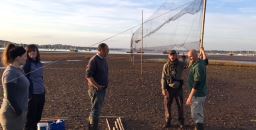High Tide 6.04 m @ 20:21, Sunset 18:10, Team meet time 16:30
 Mist-nets set at Greysands Pool, Northam Burrows © C W DeeDespite the tide being quite soon after sunset, we had decided to make one last mist-netting attempt of the winter at Greysands Pool at Northam Burrows. A team of nine set eight nets across the shallow pool and along its shoreline. The previous day's tide would have been higher, but so soon after sunset that the nets would have been visible to birds moving off of the saltmarsh onto the pool as the tide flooded. Weather conditions on the evening were ideal at this exposed site, with the light northerly dropping at dusk, but the small crescent moon was surprisingly bright in a clear sky. All nets were set by 17:45 backed by a beautiful sunset and the tape players were turned on as the last light disappeared at 18:45.
Mist-nets set at Greysands Pool, Northam Burrows © C W DeeDespite the tide being quite soon after sunset, we had decided to make one last mist-netting attempt of the winter at Greysands Pool at Northam Burrows. A team of nine set eight nets across the shallow pool and along its shoreline. The previous day's tide would have been higher, but so soon after sunset that the nets would have been visible to birds moving off of the saltmarsh onto the pool as the tide flooded. Weather conditions on the evening were ideal at this exposed site, with the light northerly dropping at dusk, but the small crescent moon was surprisingly bright in a clear sky. All nets were set by 17:45 backed by a beautiful sunset and the tape players were turned on as the last light disappeared at 18:45.
On the first net round the were signs of waders flying over the pool, but we failed to catch. A single Oystercatcher on the second net round gave some optimism, although frequent Canada Goose activities was somewhat concerning. As expected the spring tide covered the saltmarsh, but as it began to recede it was clear that no more birds were moving. The team effected an efficient pack up and we were off site just before 10pm.
It is still worth persevering with this site earlier in the winter when there are more birds around, but we will be looking for other potential sites on the Taw-Torridge next autumn.
Thanks are extended to Mike Day and Rose Roberts at Northam Burrows Country Park for arranging permission and allowing out-of-hours access and of course to the team of volunteers who made this attempt possible.
